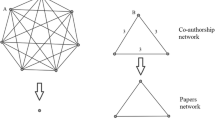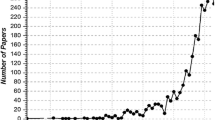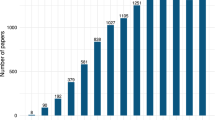Abstract
Although co-authorship in scientific research has a long history the analysis of co-authorship network to explore scientific collaboration among authors is a relatively new research area. Studies of current literature about co-authorship networks mostly give emphasis to understand patterns of scientific collaborations, to capture collaborative statistics, and to propose valid and reliable measures for identifying prominent author(s). However, there is no such study in the literature which conducts a longitudinal analysis of co-authorship networks. Using a dataset that spans over 20 years, this paper attempts to explore efficiency and trend of co-authorship networks. Two scientists are considered connected if they have co-authored a paper, and these types of connections between two scientists eventually constitute co-authorship networks. Co-authorship networks evolve among researchers over time in specific research domains as well as in interdisciplinary research areas. Scientists from diverse research areas and different geographical locations may participate in one specific co-authorship network whereas an individual scientist may belong to different co-authorship networks. In this paper, we study a longitudinal co-authorship network of a specific scientific research area. By applying approaches to analyze longitudinal network data, in addition to known methods and measures of current co-authorship literature, we explore a co-authorship network of a relatively young and emerging research discipline to understand its trend of evolution pattern and proximity of efficiency.








Similar content being viewed by others
References
Bavelas, A. (1950). Communication patterns in task-oriented groups. Journal of the Acoustical Society of America, 22, 725–730.
Beaver, D. B., & Rosen, R. (1978). Studies in scientific collaboration. Scientometrics, 1(1), 65–84.
Bornmann, L., & Daniel, H. D. (2010). The citation speed index: A useful bibliometric indicator to add to the H index. Journal of Informetrics, 4(3), 444–446.
Bornmann, L., Mutz, R., Hug S. E., & Daniel, H. D. (2011). A multilevel meta-analysis of studies reporting correlations between the h index and 37 different h index variants. Journal of Informetrics, 5(3), 346–359.
Cho, C. C., Hu, M. W., & Liu, M. C. (2010). Improvements in productivity based on co-authorship: a case study of published articles in China. Scientometrics, 85(2), 463–470.
Cunningham, S. J., & Dillon, S. M. (1997). Authorship patterns in information systems. Scientometrics, 39(1), 19–27.
Ding-quan, C., Wei-feng, Z., & Xiu-juan, M. (2009). Study of the periodical paper co-authorship of library and information science: 1999–2002. Information Science. doi:CNKI:SUN:QBKX.0.2009-01-015.
Einstein, A., & Straus, E. G. (1945). The influence of the expansion of space on the gravitation fields surrounding the individual stars. Reviews of Modern Physics, 17(2–3), 120–124.
Folias, E. (1970). On the theory of fracture of curved sheets. Engineering Fracture Mechanics, 2(2), 151–164.
Grossman, J. W., & Ion, P. D. F. (1995). On a portion of the well-known collaboration graph. Congressus Numerantium 108, 129–132.
Hoffman, P. (1998). The man who loved only numbers: The story of Paul Erdos and the search for mathematical truth. New York: Hyperion.
Huang, M. H., & Chang, Y. W. (2011). A study of interdisciplinarity in information science: Using direct citation and co-authorship analysis. Journal of Information Science. doi:10.1177/0165551511407141.
Huang, T. H., & Huang, M. L. (2006). Analysis and visualization of co-authorship networks for understanding academic collaboration and knowledge domain of individual researchers. In Proceedings of CGIV'2006 (pp. 18–23).
Inzelt, A., Schubert, A., & Schubert, M. (2009). Incremental citation impact due to international co-authorship in Hungarian higher education institutions. Scientometrics, 78(1), 37–43.
Kretschmer, H. (1994). Coauthorship networks of invisible colleges and institutionalized communities. Scientometrics, 30(1), 363–369.
Liu, X., Bollen, J., Nelson M. L., & Van de Sompel, H. (2005). Co-authorship networks in the digital library research community. Information Processing & Management, 41(6), 1462–1480.
Luukkonen, T., Persson, O., & Sivertsen, G. (1992). Understanding patterns of international scientific collaboration. Science, Technology & Human Values, 17(1), 101.
Luukkonen, T., Tijssen, R. J. W., et al. (1993). The measurement of international scientific collaboration. Scientometrics, 28(1), 15–36.
Medoff, M. H. (2006). The efficiency of self-citations in economics. Scientometrics, 69(1), 69–84.
Meho, L. I., & Yang, K. (2007). Impact of data sources on citation counts and rankings of LIS faculty: Web of Science versus Scopus and Google Scholar. Journal of the American Society for Information Science and Technology, 58(13), 2105–2125.
Melin, G., & Persson, O. (1996). Studying research collaboration using co-authorships. Scientometrics, 36(3), 363–377.
Newman, M. E. J. (2001). The structure of scientific collaboration networks. Proceedings of the National Academy of Sciences of the USA 98(2), 404.
Newman, M. E. J. (2004). Coauthorship networks and patterns of scientific collaboration. Proceedings of the National Academy of Sciences of the USA 101(Suppl 1), 5200.
Persson, O., & Beckmann, M. (1995). Locating the network of interacting authors in scientific specialties. Scientometrics, 33(3), 351–366.
Schubert, A. (2009). Using the h-index for assessing single publications. Scientometrics, 78(3), 559–565.
Scott, J. (2000). Social network analysis: A handbook. London: Sage Publications Ltd.
Strauss, E., & Erdos, P. (1953). On linear independence of sequences in a Banach space. Pacific Journal of Mathematics, 3, 689–694.
Wasserman, S., & Faust, K. (2003). Social network analysis: Methods and applications. Cambridge: Cambridge University Press.
Author information
Authors and Affiliations
Corresponding author
Rights and permissions
About this article
Cite this article
Uddin, S., Hossain, L., Abbasi, A. et al. Trend and efficiency analysis of co-authorship network. Scientometrics 90, 687–699 (2012). https://doi.org/10.1007/s11192-011-0511-x
Received:
Published:
Issue Date:
DOI: https://doi.org/10.1007/s11192-011-0511-x




